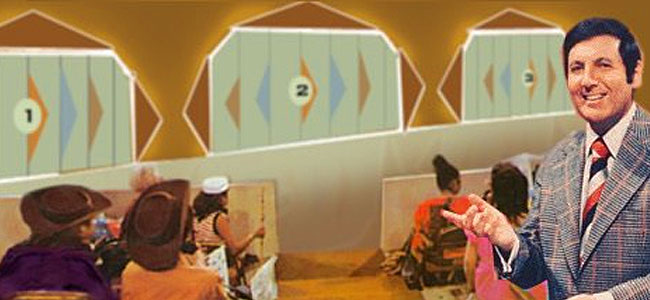- Hypothesis testing
- Bayesian statistics
- Decision making
- Dangers
EDS 212: Day 5, Lecture 1
Basic probability theory
August 8th, 2025
The Monty Hall problem

Monty Hall Problem, by Numberphile
Why refresh probability?
Probability
Definition: the likelihood that an event or outcome occurs. Typically, \(P = 0\) indicates no chance of an event or outcome happening, \(P=1\) indicates it happens with certainty.
Terminology
Event space: The collection of all possible unique outcomes of an experiment or scenario. Also called the sample space.
Event: A possible outcome (or combination of outcomes). The probability of event \(A\) occurring is written as \(P\{ A \}\).
The probability is the long term relative frequency of an event occurring, given all outcomes of the event space.
Law of large numbers
If you repeat an experiment independently a large number of times, the calculated statistic (e.g. mean, proportion ‘true’, etc.) will be close to the true (expected) parameter.
Example: Proportion “heads” over a long run of coin flips, with a fair coin.
Basic probability theory, notation, and diagrams
- Intersection: Probability that outcomes co-occur. In other words, these are AND probability statements.
- Union: Probability that at least one outcome in the event space happens (could be just one, or all). In other words, these are OR probability statements.
- Complement: Probability that an outcome or set of outcomes does not occur
Intersection
Notation: \(P\{A\cap B\}\)
In words: The probability of A and B happening (where A and B are independent events)
Calculation: \(P\{A\cap B\} = P\{A\}*P\{B\}\)
Union
Notation: \(P\{A\cup B\}\)
In words: The probability of A or B happening (i.e., at least A or B happens, or both).
Calculation: \(P\{A\cup B\}=P\{A\}+P\{B\}-P\{A\cap B\}\)
Complement
Notation: \(P\{A'\}\)
In words: The probability of \(A\) NOT happening
Calculation: \(P\{A'\}=1-P\{A\}\)
Conditional probability
If events are not independent, one event having occurred can change the probability of another event occurring. For events \(A\) and \(B\), the probability of \(B\) given that \(A\) is know to occur is:
\(P\{B|A\}=\frac{P\{A \cap\ B\}}{P\{A\}}\)
A common question: Why doesn’t this just simplify to \(P\{B\}\) if the intersection is \(P\{A\}*P\{B\}\)?
Intuition check
The following are jitterplots (overlaying violin plots) of flipper length for Adélie, Chinstrap and Gentoo penguins recorded by Dr. Kristen Gorman at islands in Palmer Archipelago, Antarctica.
We’ll consider: given some mystery penguins with different flipper lengths, how might the length inform which species we think it is?

Terms
Population: The entire collection of things in a category you are trying to understand. You define the population. For example: Santa Barbara registered voters, Ponderosa pines in Inyo National Forest, purple urchins in Channel Islands Marine Sanctuary.
Sample: A subset of the population, goal is to be representative of the population
Parameter: A characteristic of the population
Statistic: A characteristic of the sample
Inference
Usually, we don’t have the resources (time, money, human power, etc.) to collect observations for an entire population. As a proxy, we try to collect a representative sample.
Then, we attempt to draw conclusions about the populations from which our samples were collected.
Probability density function
On Day 4, we visualized data distributions from histograms. If we use histograms to estimate continuous functions that describe all possible outcomes, we have created a probability density function.
The area under any probability density function = 1, indicating that 100% of all possible outcomes are represented by the function.
Drawing fun!
This gives us a basis for hypothesis testing (EDS 222)
If a null hypothesis is true, what is the probability that your data outcome (e.g. mean, value, etc.) or something more extreme would have occurred by random chance?
Is that so unlikely (is the probability low enough), that you think you have sufficient evidence to reject the null hypothesis? Or not?
Let’s brainstorm some examples (and to be continued…)